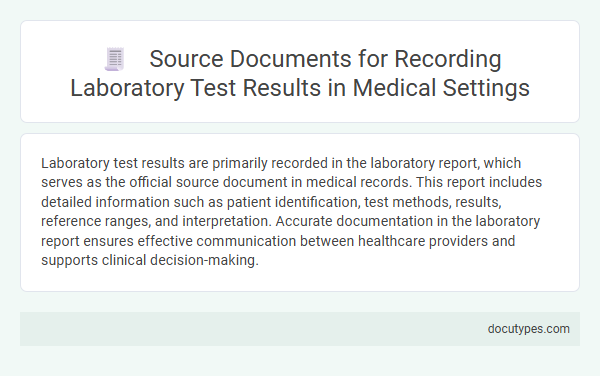Laboratory test results are primarily recorded in the laboratory report, which serves as the official source document in medical records. This report includes detailed information such as patient identification, test methods, results, reference ranges, and interpretation. Accurate documentation in the laboratory report ensures effective communication between healthcare providers and supports clinical decision-making.
Introduction to Source Documents in Medical Laboratories
Source documents in medical laboratories serve as the primary records for capturing laboratory test results accurately and reliably. These documents include test requisition forms, laboratory notebooks, and electronic health records that ensure traceability and data integrity. Proper use of source documents is essential for maintaining compliance with regulatory standards and supporting accurate diagnosis and patient care.
Importance of Accurate Laboratory Test Documentation
Laboratory test results are primarily recorded in the laboratory information system (LIS), which serves as the official source document for documenting and managing test data. Accurate documentation in the LIS ensures reliable patient diagnoses, effective treatment plans, and legal compliance within healthcare settings.
- Laboratory Information System (LIS) - The LIS is the centralized digital platform used for recording, storing, and tracking laboratory test results.
- Accuracy in Documentation - Precise entry of test results in the LIS prevents diagnostic errors and supports timely clinical decision-making.
- Regulatory and Legal Standards - Proper documentation in the source record meets compliance requirements and facilitates audits and quality control.
Types of Source Documents in Laboratory Settings
In laboratory settings, source documents are essential for accurately recording test results. These documents ensure traceability and reliability of laboratory data.
Common types of source documents include laboratory requisition forms, electronic laboratory information systems (LIS), and test result worksheets. Laboratory requisition forms contain patient information and requested tests, serving as the initial record. Electronic LIS platforms facilitate real-time data entry and management, improving accuracy and accessibility of test outcomes.
Regulatory Requirements for Laboratory Recordkeeping
| Aspect | Details |
|---|---|
| Source Document for Laboratory Test Results | Laboratory Test Reports or Raw Data Sheets serve as primary source documents for recording laboratory test results. |
| Content of Source Documents | Include sample identification, test methods, instrumentation used, raw data, calculations, and final test outcomes. |
| Regulatory Requirements |
|
| Record Retention | Regulations often require retention of laboratory records for a minimum of 2 to 5 years depending on study type and regulatory body. |
| Integrity and Traceability | Source documents must be time-stamped, signed or electronically authenticated, and maintained in a secure, accessible manner. |
| Role in Audits and Inspections | Source documents provide objective evidence during regulatory audits, supporting data authenticity, completeness, and compliance. |
Essential Information to Include in Laboratory Test Records
The primary source document used for recording laboratory test results is the laboratory report or test requisition form. These documents ensure accurate communication of patient data and test outcomes between the laboratory and healthcare providers.
Essential information in laboratory test records includes patient identification details, test type, and results with reference ranges.
- Patient Identification - Includes patient name, ID number, date of birth, and specimen collection date to ensure test results correspond to the correct individual.
- Test Information - Specifies the type of laboratory test performed, such as blood glucose or CBC, to clarify diagnostic purposes.
- Results and Reference Ranges - Contains actual test values and normal reference intervals to facilitate interpretation and clinical decision-making.
Electronic vs. Paper-Based Laboratory Source Documents
The primary source document for recording laboratory test results is the laboratory report, which can be either electronic or paper-based. Electronic laboratory source documents offer increased accuracy, faster access, and easier integration with electronic health records (EHR), while paper-based documents remain common in some facilities due to simplicity and established workflows. Your choice between these formats impacts data management, accessibility, and patient care quality in clinical settings.
Role of Laboratory Information Management Systems (LIMS)
Source documents for recording laboratory test results primarily include laboratory reports and test request forms. These documents serve as the official records that capture patient data, specimen details, and the results of various laboratory analyses.
Laboratory Information Management Systems (LIMS) play a pivotal role in managing and storing these source documents electronically. LIMS enhance data accuracy, streamline workflow, and ensure secure access to test results, significantly improving laboratory efficiency and compliance with regulatory standards.
Best Practices for Ensuring Data Integrity in Test Result Records
Source documents for recording laboratory test results typically include original lab reports, electronic health records (EHRs), and validated laboratory information systems (LIS). Ensuring data integrity in these records is crucial for accurate diagnosis and patient care.
- Use Original Lab Reports - Record data directly from certified lab reports to maintain authenticity and traceability.
- Implement Electronic Systems - Utilize secure laboratory information systems with audit trails to prevent data tampering and loss.
- Regular Data Verification - Conduct routine cross-checks and validation to identify and correct discrepancies promptly.
Your adherence to these best practices strengthens the reliability of laboratory test result documentation and supports quality healthcare delivery.
Handling Confidentiality and Security of Laboratory Documents
The primary source document used for recording laboratory test results is the laboratory report. This document includes essential patient information, test types, results, and interpretation by medical professionals.
Handling the confidentiality and security of laboratory documents requires strict adherence to privacy regulations such as HIPAA. You must ensure that access to these documents is limited to authorized personnel only to protect patient information from unauthorized disclosure.
What Source Document Is Used for Recording Laboratory Test Results? Infographic

